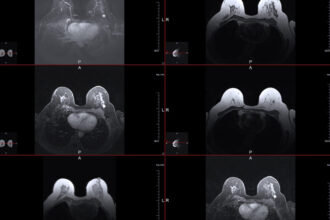Topline
Pirola, or BA.2.86, is the third most prevalent Covid strain in the U.S., and although there may be concerns the new monovalent vaccines—which protect against the XBB lineage that Pirola isn’t a part of—don’t offer protection against Pirola and its subvariants, drugmakers and the CDC are sure the vaccines offer defense.
A hand with a medical syringe is seen in front of a text “Pirola BA.2.86 SARS-CoV-2” of a spreading … [+]
Key Facts
Pirola made up 8.8% of cases as of November 25, almost triple the number of cases the variant made up during the previous two-week period ending on November 11, when Pirola wasn’t even one of the top five most prevalent variants, according to data from the Centers for Disease Control and Prevention.
It’s circulating the most in the Northeast, where it’s the second most common variant in the region (13%) after HV.1.
Pirola joined four other variants as “variants of interest” by the World Health Organization on Monday, a step up from its “variant under monitoring” label in August.
Both Pfizer-BioNTech and Novavax told Forbes their latest vaccines offer some protection from Pirola, and a September clinical trial from Moderna found its latest shot provided an 8.7-fold increase in protection.
The “public health risk posed by this variant is low,” according to the CDC, and updated vaccines are expected to increase protection against Pirola.
Contra
Some experts aren’t so sure Pirola and its offsprings—most notably JN.1—will be very protected under the new vaccines. The authors of a bioRxiv study wrote in a pre-publication comment, which hasn’t yet been peer reviewed, that the newer vaccines could spur the spread of the more recent Pirola viruses.
Key Background
It’s unknown whether Pirola causes different symptoms than other variants, according to the CDC. Pirola is a part of the Omicron family and is a highly mutated offshoot of its parent variant BA.2, which was the dominant strain in 2022 and made up 85% of cases in April 2022. JN.1, one of Pirola’s mutations, has rapidly spread in other countries. It was first detected in the U.S. in September and has been found in at least 11 countries, according to the CDC.
Big Number
18,119. That’s how many hospitalizations the U.S. saw the week of November 18, according to the CDC. This is up almost 9% from the previous week. There was an 8.3% increase in deaths—506—that same week.
Tangent
HV.1 is the most prevalent Covid strain in the U.S., and made up 31.7% of cases as of November 25. It first took the lead in late October, knocking EG.5, or the “Eris” variant down to second place. Eris made up 13.1% of cases as of November 25 and is the ancestor of HV.1. Both variants are of the XBB lineage, so the new Covid vaccines offer protection against them. Though HV.1 is highly transmissible, “there’s no evidence that it’s more severe” than other variants, Ross Kedl, professor of immunology and microbiology at University of Colorado Anschutz School of Medicine, told Health.
Surprising Fact
Because of the amount of cases it made up, Pirola was previously lumped together with other BA lineage variants on the CDC’s variant tracker. It wasn’t listed as a stand alone variant until the November 11 data was released.
Further Reading
What We Know About ‘Eris’ Covid Variant EG.5: The Dominant Strain Driving An Uptick In Cases (Forbes)
FDA Authorizes Novavax’s New Covid Vaccine Designed To Protect Against The Latest Strain (Forbes)
New Covid Boosters Expected This Fall: Why Some Doctors Suggest Holding Off On Getting Your Next Booster Until Then (Forbes)
It’s Okay To Get Your Covid, Flu And RSV Shots At The Same Time, Experts Say (Forbes)









